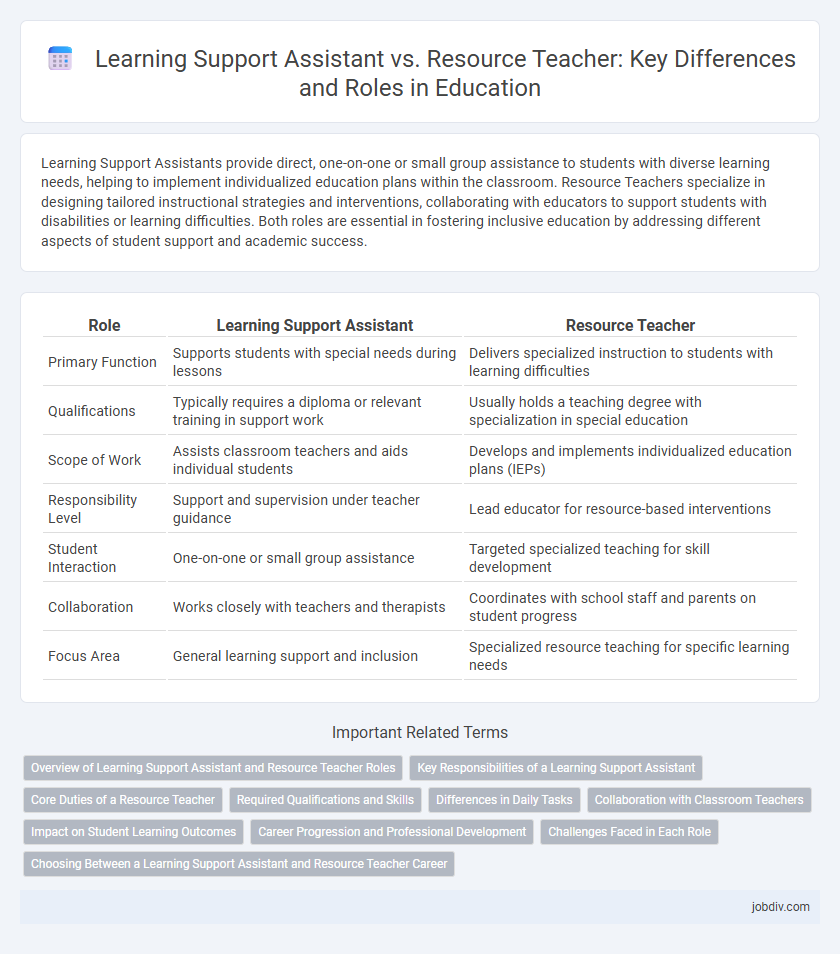Learning Support Assistants provide direct, one-on-one or small group assistance to students with diverse learning needs, helping to implement individualized education plans within the classroom. Resource Teachers specialize in designing tailored instructional strategies and interventions, collaborating with educators to support students with disabilities or learning difficulties. Both roles are essential in fostering inclusive education by addressing different aspects of student support and academic success.
Table of Comparison
| Role | Learning Support Assistant | Resource Teacher |
|---|---|---|
| Primary Function | Supports students with special needs during lessons | Delivers specialized instruction to students with learning difficulties |
| Qualifications | Typically requires a diploma or relevant training in support work | Usually holds a teaching degree with specialization in special education |
| Scope of Work | Assists classroom teachers and aids individual students | Develops and implements individualized education plans (IEPs) |
| Responsibility Level | Support and supervision under teacher guidance | Lead educator for resource-based interventions |
| Student Interaction | One-on-one or small group assistance | Targeted specialized teaching for skill development |
| Collaboration | Works closely with teachers and therapists | Coordinates with school staff and parents on student progress |
| Focus Area | General learning support and inclusion | Specialized resource teaching for specific learning needs |
Overview of Learning Support Assistant and Resource Teacher Roles
Learning Support Assistants provide individualized support to students with diverse learning needs, facilitating classroom integration and enhancing student engagement through tailored interventions. Resource Teachers specialize in designing and implementing specialized educational programs, assessing student progress, and collaborating with educators to adapt curricula for inclusive learning environments. Both roles are integral to supporting differentiated instruction and promoting academic success for students with special educational requirements.
Key Responsibilities of a Learning Support Assistant
Learning Support Assistants primarily provide one-on-one or small group support to students with special educational needs, implementing individualized learning plans and assisting with classroom activities under the direction of the resource teacher. Key responsibilities include monitoring student progress, adapting teaching materials to accommodate diverse learning styles, and facilitating communication between students, teachers, and parents. They play a vital role in promoting inclusive education by supporting behavior management and encouraging student participation across various subjects.
Core Duties of a Resource Teacher
A Resource Teacher plays a pivotal role in designing and implementing individualized education plans (IEPs) for students with special needs, ensuring tailored instructional strategies and learning accommodations. They collaborate closely with classroom teachers, parents, and specialists to monitor student progress and adjust interventions accordingly. Unlike Learning Support Assistants who primarily provide in-class support, Resource Teachers lead specialized instruction and coordinate resources to enhance student outcomes across diverse learning environments.
Required Qualifications and Skills
Learning Support Assistants typically hold qualifications such as a high school diploma or equivalent with specialized training in special education or child development, emphasizing skills in classroom support, behavior management, and individualized student assistance. Resource Teachers require a bachelor's degree in education with certification in special education, demonstrating expertise in curriculum adaptation, student assessment, and individualized education program (IEP) development. Both roles demand strong communication, patience, and collaborative skills to effectively support diverse learning needs, but Resource Teachers carry additional responsibilities in instructional leadership and specialized intervention strategies.
Differences in Daily Tasks
Learning Support Assistants primarily provide one-on-one or small group support to students with special educational needs during classroom activities, facilitating individualized learning and behavior management. Resource Teachers coordinate specialized instruction plans, assess student progress, and collaborate with classroom teachers to modify curriculum and implement targeted interventions. While Learning Support Assistants focus on direct student interaction, Resource Teachers concentrate on planning, assessment, and teacher support to enhance overall educational outcomes.
Collaboration with Classroom Teachers
Learning Support Assistants work closely with classroom teachers to provide individualized support for students with diverse learning needs, ensuring inclusive education and effective differentiation strategies. Resource Teachers collaborate with classroom teachers to develop tailored instructional plans, monitor student progress, and implement specialized interventions for learners requiring additional academic assistance. Strong collaboration between these roles enhances overall student achievement and fosters a supportive, adaptive learning environment.
Impact on Student Learning Outcomes
Learning Support Assistants (LSAs) provide individualized support within the classroom, promoting inclusive learning environments and helping students with diverse learning needs stay engaged and on task. Resource Teachers specialize in targeted instruction and intervention strategies, addressing specific academic challenges to improve literacy, numeracy, and overall student achievement. Both roles contribute significantly to enhancing student learning outcomes by adapting teaching methods and facilitating personalized educational experiences.
Career Progression and Professional Development
Learning Support Assistants often begin their careers providing one-on-one student support, gaining hands-on experience before pursuing further qualifications to transition into Resource Teacher roles. Resource Teachers typically have advanced certifications and undertake specialized training in educational strategies, enhancing their career progression through leadership opportunities and involvement in curriculum development. Professional development for Resource Teachers includes workshops, mentoring, and continuing education that build expertise in inclusive education and individualized learning plans.
Challenges Faced in Each Role
Learning Support Assistants often face challenges such as managing diverse student needs and providing individualized attention within large classrooms. Resource Teachers encounter difficulties in designing specialized curricula and coordinating interventions across various grade levels and subjects. Both roles require strong communication skills and adaptability to effectively support students with varied learning abilities.
Choosing Between a Learning Support Assistant and Resource Teacher Career
Choosing between a Learning Support Assistant and a Resource Teacher career depends on the level of responsibility and specialization desired in educational support roles. Learning Support Assistants provide direct, individualized support to students with diverse needs in classroom settings, focusing on implementation rather than planning, while Resource Teachers design and deliver specialized instructional programs, assess student progress, and collaborate with teachers to adapt curricula for learners with disabilities or learning difficulties. Career advancement opportunities and qualifications differ, with Resource Teachers typically requiring advanced certifications and offering greater involvement in educational planning and intervention strategies.
Learning Support Assistant vs Resource Teacher Infographic

 jobdiv.com
jobdiv.com